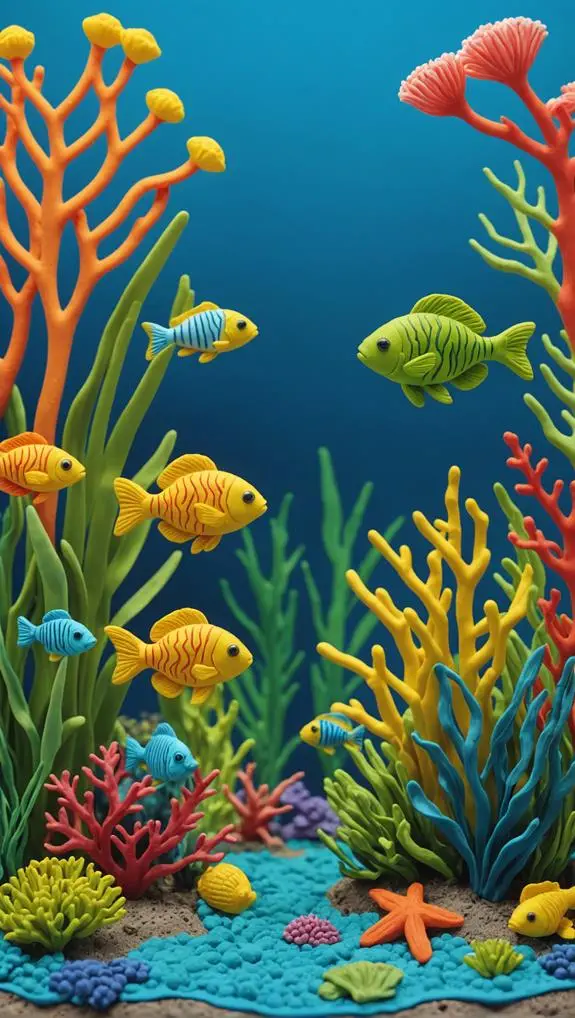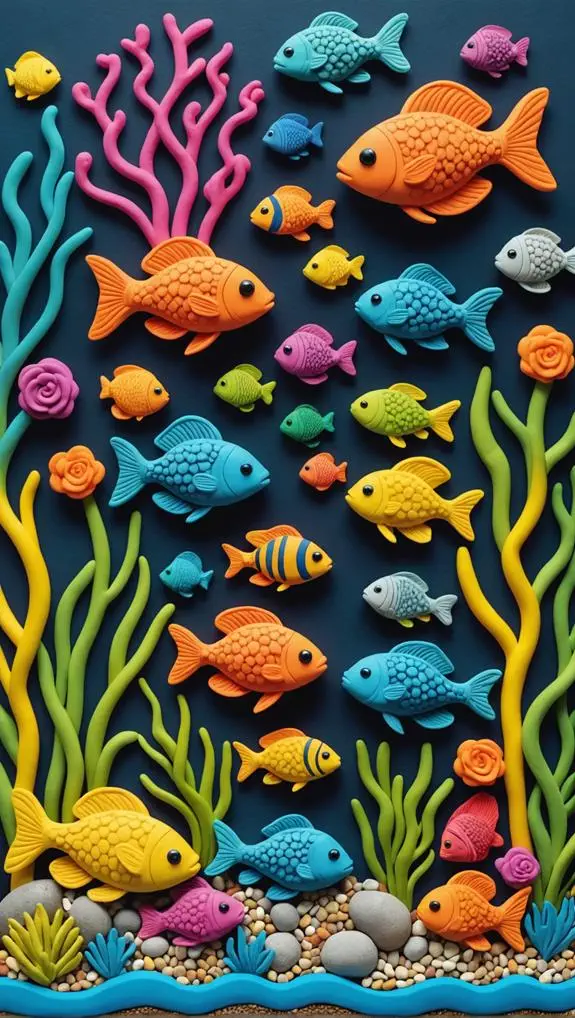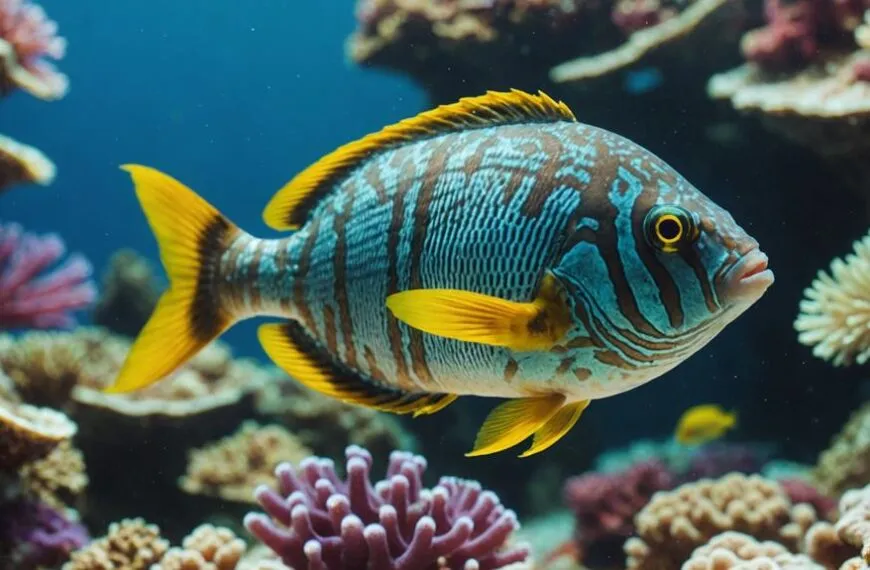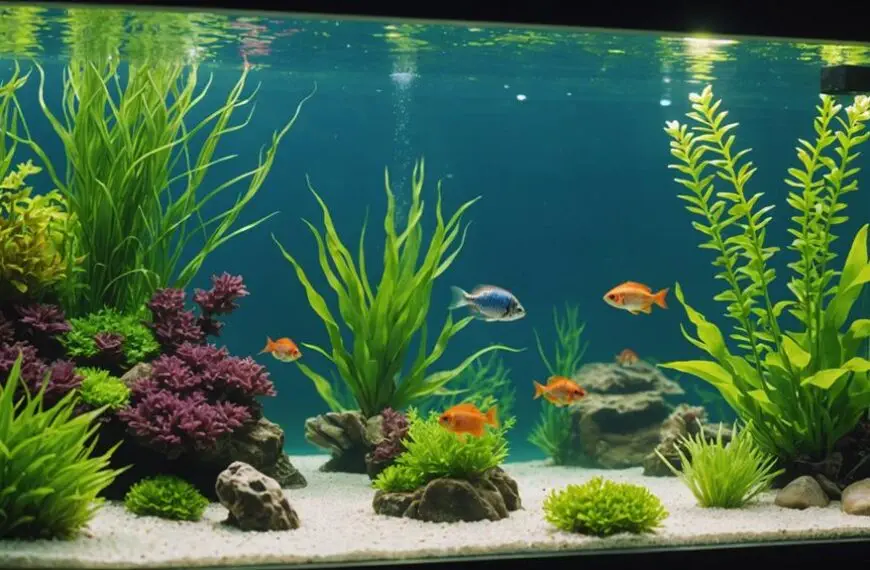Aquarium fish can face quite a few pesky parasites that can really mess with their health. You might encounter things like "Ich," which shows up as white spots and can make your fish twitchy and lethargic. Then there are fish lice and anchor worms, both causing skin irritation and discomfort. Don't forget about gill flukes that can make breathing tricky! And let's not overlook those sneaky protozoan parasites like Hexamita, which can cause serious gut issues. Keeping an eye on your fish's behavior helps spot problems early, so stick around to discover more ways to keep your finned friends happy and healthy!
Contents
Common Ectoparasites
When it comes to keeping your aquarium fish healthy, understanding common ectoparasites is crucial. These pesky little critters can cause a lot of trouble if you're not careful.
One of the most notorious is *Ichthyophthirius multifiliis*, or simply ich. You might spot it as small white dots on your fish. When they start scratching against surfaces, it's time to act!
Then, there are fish lice, which are tricky to see. These little crustacean ectoparasites cling to your fish's skin and can lead to irritation and infections.
Anchor worms, with their anchor-shaped heads, burrow into the flesh, causing tissue damage. Yikes!
Don't forget about gill flukes. These flatworms invade fish gills, making it hard for your fish to breathe. You might notice them gasping at the surface.
Lastly, we've got Trichodina, another ciliate that can cause excessive mucus and gill irritation.
Keeping an eye out for these visible parasites can help you prevent serious disease in your freshwater fish. So, stay vigilant, and your fish will thank you with their happy little swims!
Internal Protozoan Parasites
Internal protozoan parasites can silently wreak havoc on your aquarium fish, leading to serious health issues if not caught early.
These sneaky invaders, like Hexamita and Spironucleus, can cause noticeable symptoms such as weight loss and an unusual belly appearance—often referred to as "hole in the head" disease.
You might also encounter Trypanosoma infections, especially in wild-caught fish, which can lead to severe anemia and increased mortality rates.
Keeping an eye out for signs like lethargy and abnormal swimming behaviors will help you catch these infections before they escalate.
To diagnose these pesky parasites, you can use fresh smears or biopsies to identify living organisms within the fish's tissues.
If you do find internal protozoan parasites, don't fret! Metronidazole is a go-to treatment that effectively targets these infections.
Ciliate Infections

Ciliate infections can pose a serious threat to your aquarium fish, often leading to distress and, if untreated, significant mortality rates.
One of the most notorious culprits is Ichthyophthirius multifiliis, commonly known as "ich." This pesky parasite shows up as white spots on your fish's skin and gills, causing them to become lethargic and have clamped fins. You might also notice respiratory distress as your fish struggle to breathe.
Identifying these parasites is crucial for your fish's health. You can do this through fresh skin mucus and gill biopsies.
If you spot those white spots, it's time for action! Treatment often requires multiple applications of formalin, copper sulfate, or potassium permanganate baths.
But remember, it's not just about treating; prevention is key! Keeping an eye on water quality and managing fish density can help keep these pesky parasites at bay.
Stay proactive and monitor your fish's health regularly. After all, a happy, healthy aquarium is what we all strive for, right?
Oomycete Diseases
When it comes to oomycete diseases, you might notice some fuzzy, cotton-like growths on your fish that can be pretty alarming.
These pesky pathogens thrive in dirty water, so keeping your aquarium clean is crucial for prevention.
Don't worry, though—by knowing how to spot the signs early and using the right treatments, you can get your fish back to swimming happily in no time!
Common Oomycete Infections
Oomycete infections are a common concern for aquarium fish keepers, often leading to serious health issues and even fatalities in severe cases.
These infections are caused by oomycetes like Saprolegnia and Aphanomyces, which are sneaky little water molds. They can show up as cotton-like growths on your fish, which isn't just a fashion statement!
These infections usually strike when your fish are stressed, often due to poor water quality. When the water isn't up to snuff, your fish become more vulnerable to these nasty pathogens.
Oomycete spores are everywhere, just waiting for an opportunity. They can invade through wounds or damaged skin and gills, making it crucial to keep an eye out!
To combat these infections, focus on maintaining optimal water quality and reducing stress for your fish. Good hygiene practices in your aquarium can go a long way.
Remember, clean tanks make happy fish! While antifungal agents can help treat infections, the best defense is a good offense—so keep your aquarium clean and your fish healthy.
With a little diligence, you can create a thriving underwater paradise!
Treatment and Prevention Methods
Many aquarium keepers face the challenge of treating and preventing oomycete infections like Saprolegnia and Aphanomyces. These pesky parasites can show up as cotton-like growths on your fish, leading to serious problems if not addressed quickly.
First things first, keeping a clean environment is key. Regular water changes help maintain good water quality and ensure optimal oxygen levels, keeping your fish happy and healthy.
If you notice sick fish, consider using aquarium salt or anti-fungal medications to manage the infection. A salt bath can work wonders for fish infected with oomycete diseases, helping them regulate their bodies better.
And remember, when introducing new aquatic plants or fish to your established aquarium, always quarantine them for at least two weeks to avoid bringing in unwanted spores.
Don't forget about overcrowding! Sticking to a manageable number of fish will keep stress levels low, which is crucial for preventing outbreaks.
Nematodes and Cestodes

When it comes to pesky parasites in your aquarium, nematodes and cestodes are two troublemakers you should know about.
Nematodes, those sneaky roundworms, can really mess with your fish's gut, causing them to lose weight and feel pretty miserable.
On the other hand, cestodes, or tapeworms, latch onto the intestines and can grow quite large, leaving your fish feeling lethargic as they steal their food—yikes!
Nematode Characteristics and Effects
Nematodes, commonly known as roundworms, are cylindrical parasites that can wreak havoc on various aquarium fish species.
These sneaky little critters can infect your fish, leading to all sorts of trouble. If you notice abdominal swelling or gastrointestinal distress in your fish, it might be time to investigate further. Infected fish often display unusual swimming patterns and may lose weight, making their health a top concern.
Nematodes reproduce like crazy—females can lay thousands of eggs, so if you don't catch them early, you could be facing a full-blown infestation.
Thankfully, there are solutions! Using anthelmintic drugs, like fenbendazole or piperazine, can help you tackle these pesky worms and restore your fish's health.
To keep nematodes at bay, focus on maintaining optimal water quality.
Regular monitoring of your fish species is essential for spotting any signs of trouble before it escalates. Remember, good aqua health is all about prevention!
Cestode Life Cycle Overview
Understanding the life cycle of cestodes, or tapeworms, is crucial for maintaining the health of your aquarium fish.
These sneaky parasites often use fish as intermediate hosts during their larval stage. When a fish-eating predator, like a larger fish, consumes a fish infected with cestodes, the adult tapeworm settles in its intestines, cranking out thousands of eggs. Yikes! Those eggs get excreted in feces, contaminating the water and getting gobbled up by crustaceans or other prey. This cycle keeps on spinning.
Once a fish hosts these eggs, the larval forms, like cysticercoids or plerocercoids, develop in its tissues. This can lead to serious health issues for your finned friends, and nobody wants that!
Thankfully, there's hope. Treatment usually involves anthelmintics like praziquantel, which effectively wipe out these pesky parasites and their eggs.
Crustacean Parasites
Crustacean parasites, like fish lice and anchor worms, can wreak havoc on your aquarium fish. These pesky critters love to latch onto your fish's skin and gills, causing irritation and tissue damage that no fish owner wants to see.
Fish lice, for instance, can lead to visible wounds and skin lesions, while anchor worms burrow into the flesh, creating bleeding and further discomfort.
To keep your aquatic friends safe, quarantine measures are a must! Always separate new fish or contaminated plants before introducing them to your tank. If you notice abnormal behavior—like flashing against objects or rubbing their bodies—it could be a sign of a crustacean infestation that needs immediate attention.
Treating these parasites often involves medicated baths using copper-based treatments or formalin. However, don't forget that sometimes manual removal might be necessary for complete control.
While it may sound daunting, think of it as a little spa day for your fish! Remember, keeping your fish healthy means being proactive about their care, so stay vigilant and enjoy your beautiful aquarium. A happy fish is a healthy fish!
Frequently Asked Questions
What Are the Most Common Parasites in Aquariums?
In your aquarium journey, recognize common freshwater and saltwater parasites. You can identify symptoms, apply treatment options, and implement prevention methods. Prioritize tank maintenance and understand life cycles to protect your fish and breeding efforts.
How to Tell if Your Fish Has a Parasite?
To tell if your fish has a parasite, observe symptom identification like external signs, changes in fish behavior, gill examination, body lesions, and eating habits. Maintain water quality and tank maintenance to reduce stress factors.
What Parasite Affects Fish?
When considering what parasites affect fish, think about ich disease, velvet disease, and fish lice. Neon tetras can suffer from white spot and skin flukes, while anchor worms and gill flukes harm overall health.
What Is the Most Common Disease in Aquarium Fish?
You won't believe how often aquarium fish suffer from diseases! Proper tank maintenance, keen awareness of water quality, and effective treatment options are vital for preventing fish stress and ensuring a thriving aquatic environment. Quarantine procedures matter too!
Final Thoughts
So, there you have it! Your beloved fish aren't just swimming around looking cute; they're also prime real estate for a host of unwelcome guests. From pesky ectoparasites to sneaky nematodes, it's like a fishy version of a reality show—full of drama! But don't fret; with a little TLC and a keen eye, you can keep your aquatic pals healthy and happy. After all, who needs a fish spa when you can be the ultimate fishy guardian?












